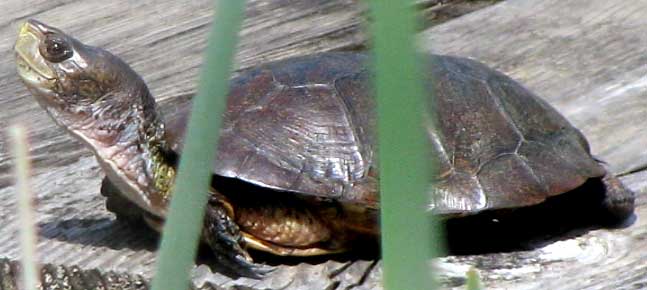Excerpts from Jim Conrad's
Naturalist Newsletter

from the May 3, 2009 Newsletter, issued from the Siskiyou Mountains west of Grants Pass, Oregon:
TURTLES ON THE BRIDGE
Unless someone has just walked by causing them to plop into the water, any sunny afternoon there's about a 90% chance that you'll find turtles basking on the wood bridge crossing the little pond just above my trailer. The bridge stands only about a foot above the water and the turtles surprisingly can climb up its sides.
I've been assuming that the turtles on the little bridge above my trailer were Red-eareds, and because they dove into the water as soon as they spotted me, I've not even tried to photograph them -- until the other day when for some reason one let me get into camera range. Then, just to have another Red-eared picture, I snapped the image shown above.
When I enlarged the photo on my laptop screen, what a surprise to find no red "ears" or any other field marks of the Red-eared Turtle. It was the Western Pond Turtle, also called Pacific Pond Turtle, CLEMMYS MARMORATA, distributed from extreme southwestern British Columbia south through western Washington, Oregon and California to northwestern Baja in Mexico.
Despite the turtle in the picture not being as yellow-spotted as the one in the Audubon field guide, it was easy to identify, mostly because in western North America we have much fewer turtle species than in the rainier East. In western Kentucky where I grew up we could look for about 12 turtle species. Here in southwestern Oregon we're within the distribution area of only the Painted Turtle (maybe just outside its range), the Red-eared -- which has been introduced here -- and our Western Pond Turtle. The first two species both bear conspicuous, yellow "tiger stripes" along their necks, so that leaves us with the Western Pond Turtle.
Notice our turtle's white mouth area. The Audubon field guide observes that "One turtle may challenge another for a favored basking site by extending its neck, opening its mouth, and exposing its yellow-edged jaws and reddish interior."
A lot of info on the species is provided at http://www.tortoise.org/archives/pacpond.html. There the author further comments on this species' vigor. He writes, " ...continued watching will reveal Pacific pond turtles in aggressive behavior as the basking site becomes crowded. Turtles push and ram each other, threaten one another with open-mouthed gestures, and occasionally bite other turtles. They are feisty turtles and their antics provide excellent outdoor entertainment." Maybe this toughness explains why Red-eareds haven't overtaken this pond.